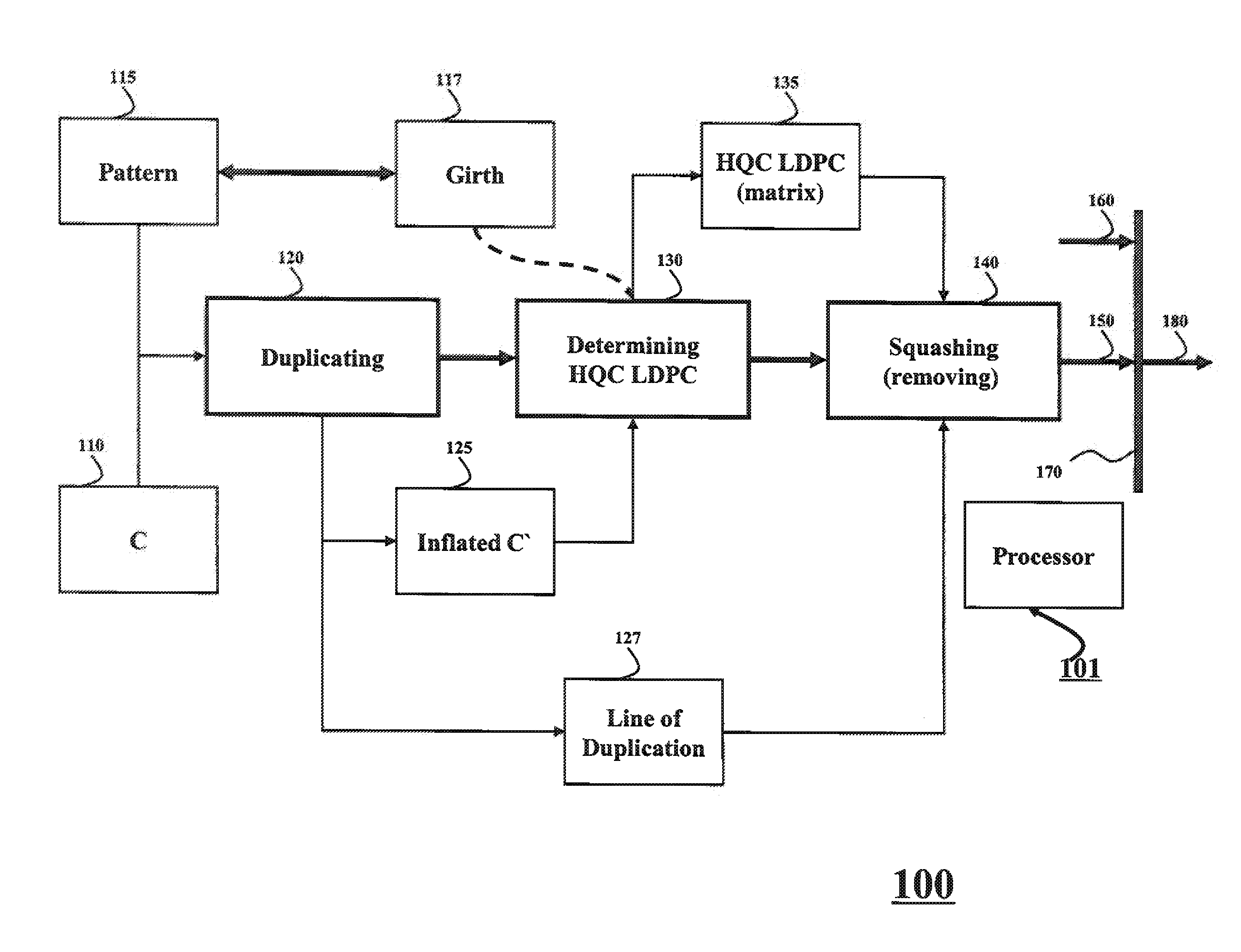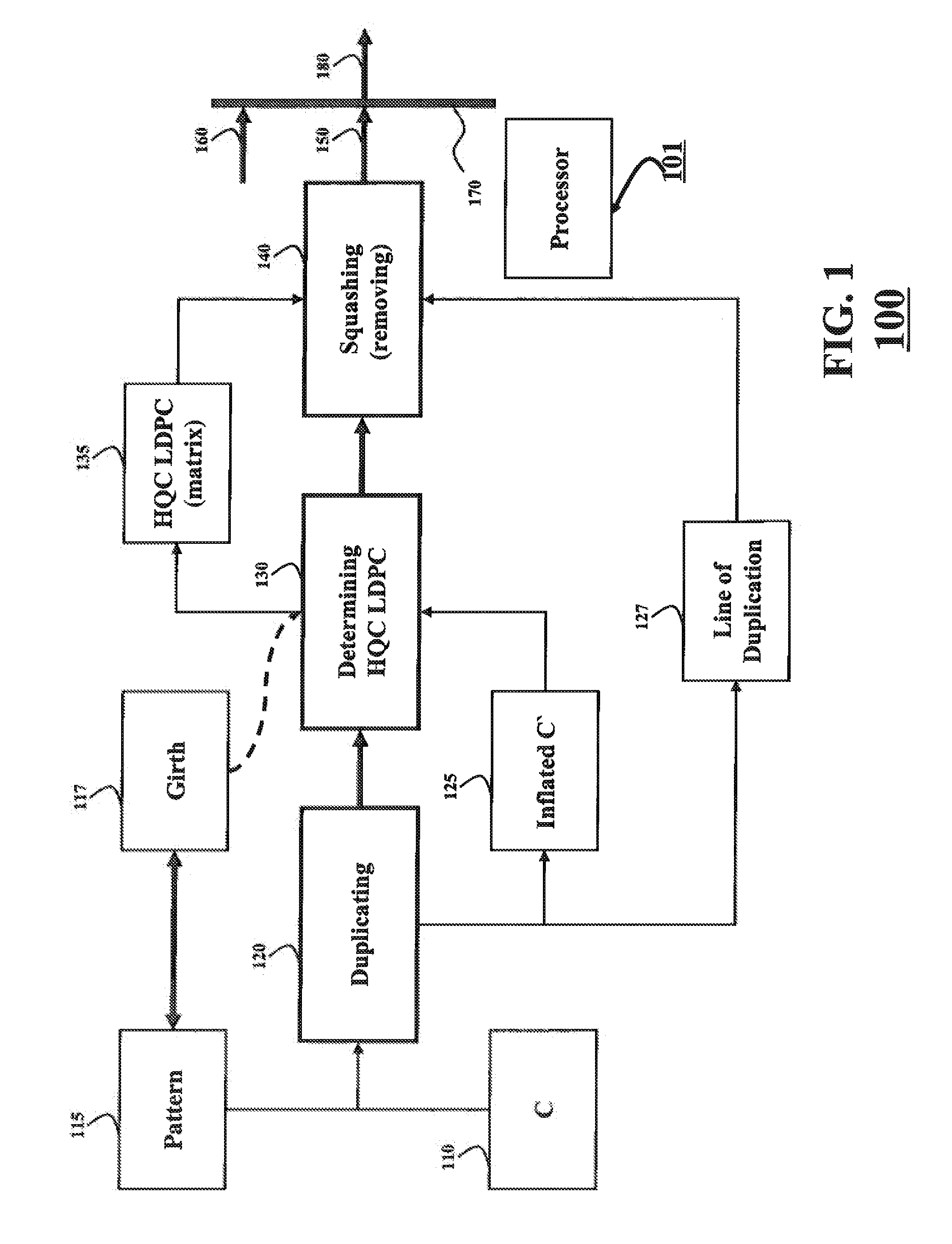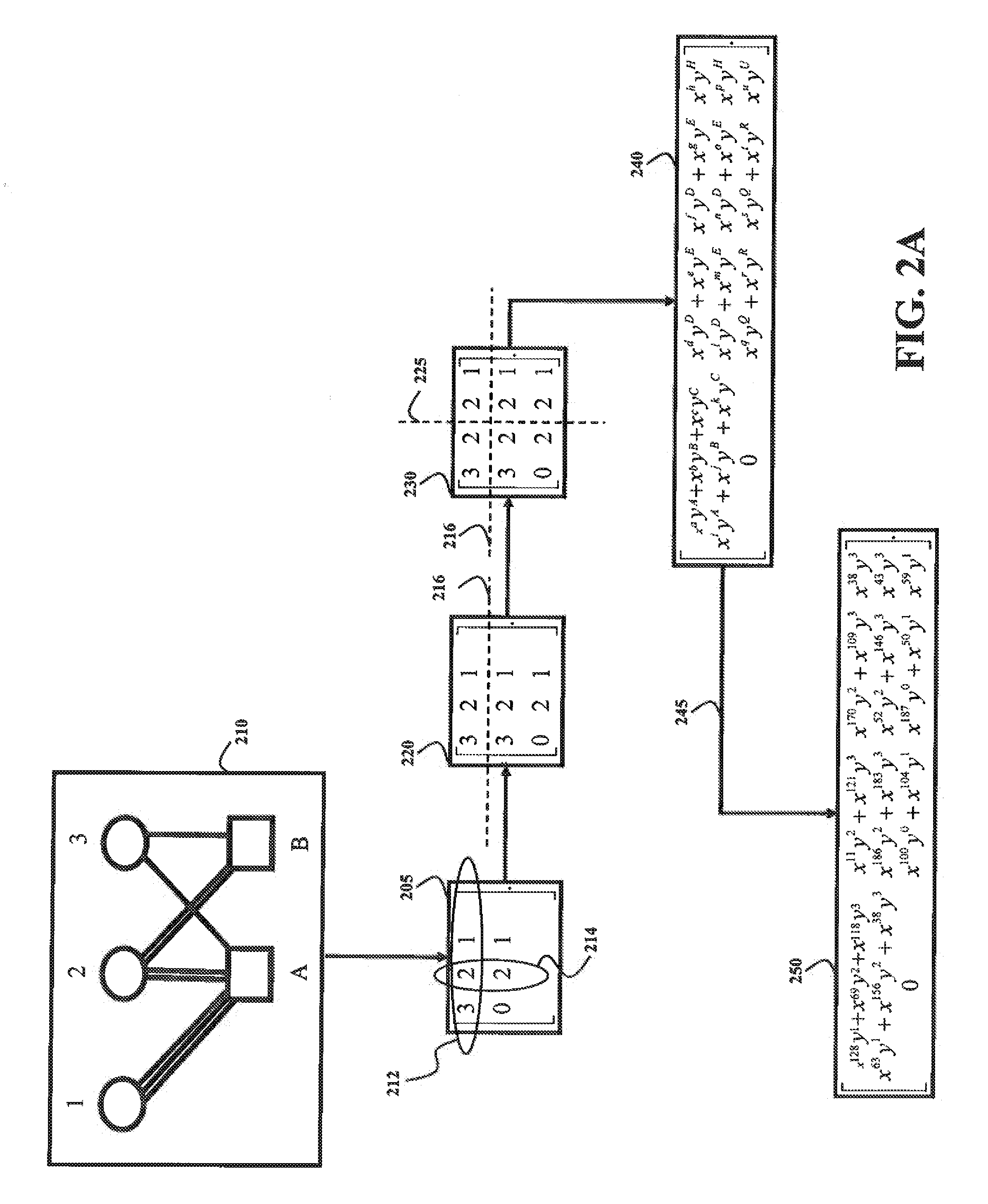System and Method for Determining Quasi-Cyclic Low-Density Parity-Check Codes Having High Girth
a low-density parity and code technology, applied in the field of determining qc low-density parity check codes having high girth, can solve the problems of not being able to optimize water-fall performance, the decoding failure rate does not continue to decrease rapidly, and the construction is not easy to implement in hardwar
- Summary
- Abstract
- Description
- Claims
- Application Information
AI Technical Summary
Benefits of technology
Problems solved by technology
Method used
Image
Examples
example 1
[0057]Let C be a length-9 QC LDPC code described by a parity check matrix
H=⌊100100100010010010001001001000100011000010101000001110⌋.(6)
[0058]For this code, J=2, L=3, and p=3, and the matrix H can be written as
H=[I0I0I00I0I1+I2].(7)
[0059]The polynomial version of the parity check matrix is
H(x)=[x0x0x00x0x1+x2]=[11101x1+x2].(8)
[0060]QC LDPC codes can be classified according to the maximum weight among the circulant sub-matrices in their parity check matrix, or equivalently, according to the maximum weight of the polynomials in their polynomial parity check matrix. The weight of a polynomial is the number of non-zero terms in that polynomial. A “weight-M” QC LDPC code is defined as one for which the maximum weight among all polynomial entries hj,l(x) in H(x) is M.
[0061]Because wt(h2,3(x))=2 in the code of Example 1, i.e., h2,3(x)=x1+x2 is a binomial, and because wt(h2,3(x))≧wt(hj,l(X)) for all 1≦j≦J, 1≦l≦L, the code in Example 1 is a weight-II QC LDPC code.
[0062]In this description, we...
example 2
[0084]For Example, consider the polynomial parity check matrix specified in equation (20) with p=8. Because the highest weight of any of the polynomial entries is 2, (e.g., h1,3(x)=x1+x7), and because there are 12 columns in the matrix, this is a length-96 weight-II QC LDPC code.
H(x)=[x20x1+x70x71+x6000x2x51x1+x7x201+x60x70001x2x50x1+x7x2x71+x60000x51x20x71+x6x20x1+x7x2x510001+x60x7x1+x7x201x2x5000x71+x600x1+x7x2x51x2000](20)
[0085]However, this parity check matrix has additional structure which makes it a hierarchical QC LDPC code. In particular, in this example, each 3×3 sub-matrix of polynomials in (20) has a circulant structure, as do both the left-hand and right-hand sets of 2×2 sub-matrices of 3×3 sub-matrices.
[0086]Just as we use polynomials in the dummy variable x to represent the underlying circulant sub-matrices in a standard QC LDPC code, we can use a bi-variate polynomial in the two dummy variables x and y to represent both the circulant matrices represented by the variab...
example 2 (
Continued)
[0094]The code of this example is a three-level HQC LDPC code. To describe this example using Definition 1, we first identify x with x[1] y with x[2], and z with x[3].
[0095]In this example p[1]=8, p[2]=3, p[3]=2. Therefore, J[3]=1, L[3]=2; J[2]=2, L[2]=4; J[1]=6, L[1]=12; and J[0]=48, L[0]=96.
[0096]We can rewrite, e.g., the term h1,1(x,y,z) of (22) as
h1,1(x[1],x[2],x[3])=x[1]2+(x[1]+x[1]7)x[2]2+(x[1]7x[2]+(1+x[1]6)x[2]2)x[3]=∑s3=01∑s2=02∑s1=07cs1,s2,s3[1,1]x[1]s1x[2]s2x[3]s3,(25)
where all coefficients cs1,s2,s3[1,1] are zero except for
c2,0,0[1,1]=c1,2,0[1,1]=c7,2,0[1,1]=c7,1,1[1,1]=c0,2,1[1,1]=c6,2,1[1,1]=1 (26)
[0097]To generate the form given in equation (4) of the polynomial parity check matrix H(x[1]) of a QC LDPC code in one variable, some embodiments use the construction of (27) for all but the first level. We can replace each hj,l(x[1], . . . , x[K]) with the polynomial matrix in x[1].
∑sK=0p[K]-1K∑s1=0p[1]-1cs1,Κ,sK[j,l](I1,p[K]sK⊗L⊗I1,p[2]s2)x[1]s1.(27)
[0098]The ma...
PUM
 Login to View More
Login to View More Abstract
Description
Claims
Application Information
 Login to View More
Login to View More - R&D
- Intellectual Property
- Life Sciences
- Materials
- Tech Scout
- Unparalleled Data Quality
- Higher Quality Content
- 60% Fewer Hallucinations
Browse by: Latest US Patents, China's latest patents, Technical Efficacy Thesaurus, Application Domain, Technology Topic, Popular Technical Reports.
© 2025 PatSnap. All rights reserved.Legal|Privacy policy|Modern Slavery Act Transparency Statement|Sitemap|About US| Contact US: help@patsnap.com



